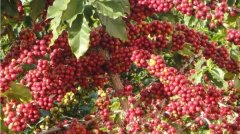Plant coffee trees correctly
If the fruit is too ripe, the beans in it will rot. If the beans are not ripe, the beans will not ripen by themselves. So bean pickers often go through the same tree several times to look for ripe fruit, but they only get two pounds of coffee beans back and forth several times, usually the average yield of a tree is 2 pounds a year.
Coffee farmers who produce low-grade coffee beans like to use labor-saving methods to harvest beans, but in this way, the quality is not pure, reducing the taste of coffee and lowering the grade of coffee. The way to pick coffee beans in some parts of Africa is to shake the coffee tree, shake the fruit to the ground, and pick it up from the ground before the fruit rotts. Low-grade coffee is produced in most parts of Brazil, where coffee is picked by picking all the leaves, flowers, ripe and green fruit from the branches at once, and it takes two years for the damaged coffee trees to recover.
The coffee tree has delicate white flowers that smell like oranges and jasmine. Sometimes it is just a tree blooming alone, like a young bride, sometimes the whole coffee garden is in full bloom, it looks like a sea of white flowers, beautiful and intoxicating. But the florescence is fleeting. Within two or three days, the petals dispersed with the wind, leaving only the remaining fragrance spinning in the air.
Before long, small fruits appear in piles, first green, then yellow, then red or crimson, and can be picked almost black. In Jamaica, bats are the first to know whether the fruit is ripe or not. by sucking coffee pulp at night, they are telling people that the fruit is ripe and ready to be picked. The oval fruit gathers tightly around the branches, with slender, smooth dark green toothed leaves on both sides of the branches. The leaves on the sunny side are harder, the back is softer, the edges are fan-shaped, and the branches are opposite from the trunk.
Coffee trees are usually bred in nurseries, grow into seedlings, and then moved to coffee plantations a year later, in full compliance with the original Arab method of planting and cultivating coffee trees. In the first four or five years of its growth, the coffee tree will continue to take root downward, develop its trunk upward, and develop into an umbrella shape so that it can bear rich fruit in the future.
Ripe and immature coffee beans

Important Notice :
前街咖啡 FrontStreet Coffee has moved to new addredd:
FrontStreet Coffee Address: 315,Donghua East Road,GuangZhou
Tel:020 38364473
- Prev

Harvesting and processing of coffee
Coffee is the fruit of a Rubiaceae plant growing about 6000 feet above sea level, distributed on the world's narrow subtropical axis; coffee trees grow green all the year round and can grow up to 20 feet tall, and are generally controlled at 8 to 10 feet for easy harvest.
- Next

Cultivation techniques of small-grain Coffee in Yunnan Province: pest Control
Small-grain coffee cultivation, coffee cultivation techniques and coffee pest control in Yunnan Province
Related
- What is the meaning of lactic acid fermentation with coffee bean treatment?
- How to judge the state of foam by sound?
- How does the latte pull out the unicorn pattern? Come to get for a little trick to improve the flower pull!
- Will flower pulling affect the taste of the latte?
- Do you know the history of coffee?
- The difference between honey treatment and sun washing what is raisin honey treatment?
- What kind of milk can a novice use to make coffee foam to keep the foam longer? The correct method and skills of milking tutorial sharing
- Why do washed coffee beans taste sour? Flavor characteristics of washed Coffee
- Introduction to the skill of how to practice the size and height of water injection around the circle of hand-brewed coffee
- How do beginners practice coffee flower drawing from scratch?

